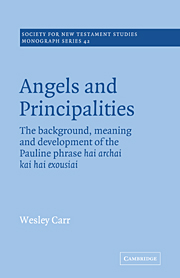 Angels and Principalities
Angels and Principalities It has not been my aim in this section to study intensively the material of Christian history between the time of Paul and the writings of Origen. Rather, by selection of some of the most important and representative authors, I have attempted to show the trends of thought on demonic forces and upon Christ's relationship to them. In reading much of the ancillary material, which is not here discussed, I have found nothing that contradicts what is here presented.
The Judaeo-Christian tradition provides the basic material from which all later ideas develop. Thus the angels are generally understood as the servants and messengers of God. The understanding of demons and of evil is tied usually to two points. The first is that of exorcism, which, being still an experience of the Church, naturally fostered an understanding of demons that the Church found in its Gospels. The second is that of the fall of Satan, which at an early stage began to take precedence over the fall of man and the lust of the angels, with the consequence that a position of leadership and importance was attributed to Satan or the Devil, which he could not have held even in the extremes of Jewish apocalyptic. The image of the struggle was important both for the moral life of the Christians and later in understanding persecution and martyrdom.
To save this book to your Kindle, first ensure [email protected] is added to your Approved Personal Document E-mail List under your Personal Document Settings on the Manage Your Content and Devices page of your Amazon account. Then enter the ‘name’ part of your Kindle email address below. Find out more about saving to your Kindle.
Note you can select to save to either the @free.kindle.com or @kindle.com variations. ‘@free.kindle.com’ emails are free but can only be saved to your device when it is connected to wi-fi. ‘@kindle.com’ emails can be delivered even when you are not connected to wi-fi, but note that service fees apply.
Find out more about the Kindle Personal Document Service.
To save content items to your account, please confirm that you agree to abide by our usage policies. If this is the first time you use this feature, you will be asked to authorise Cambridge Core to connect with your account. Find out more about saving content to Dropbox.
To save content items to your account, please confirm that you agree to abide by our usage policies. If this is the first time you use this feature, you will be asked to authorise Cambridge Core to connect with your account. Find out more about saving content to Google Drive.